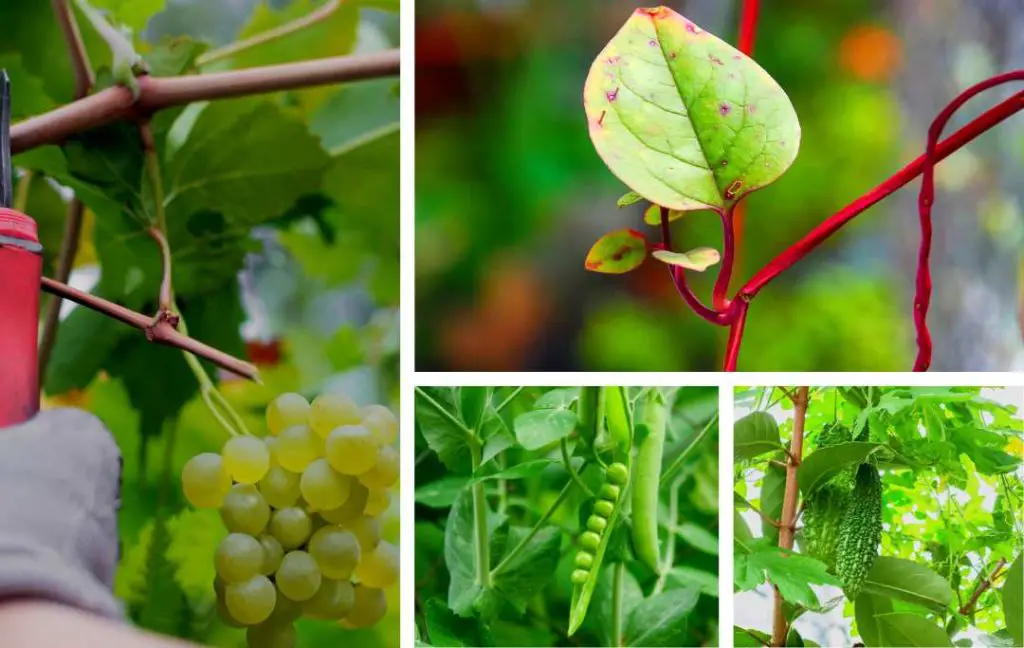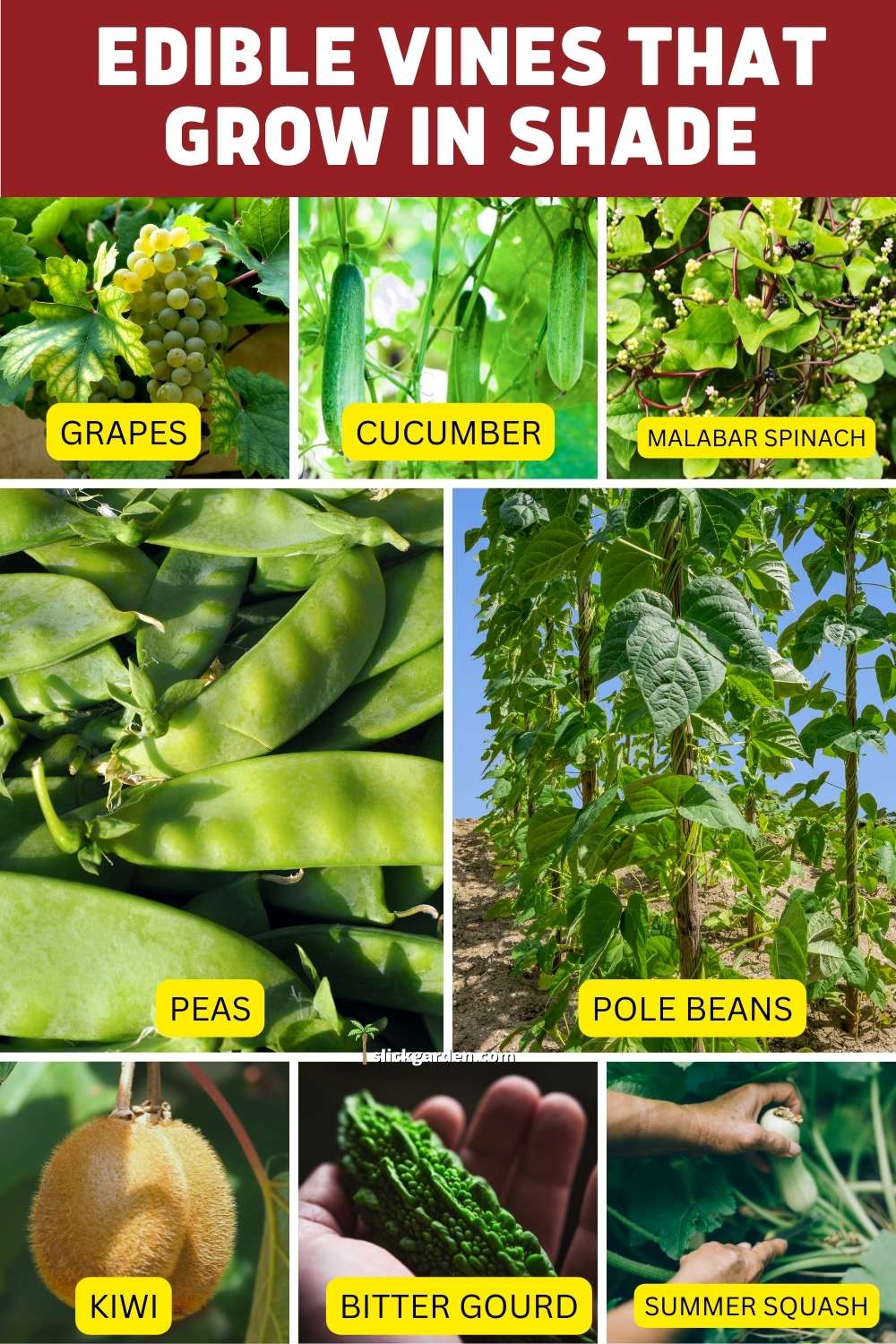Vertical gardening is perfect for confined spaces. You can suspend plastic bottles and PVC pipes alongside walls and fences. You can use other different wasted materials for decorating your walls and roofs. It will enhance the beauty of your garden or backyard.
But these containers need higher maintenance. So if we use vines to add greenery to your yard or garden then they can easily spread on your wall and need little maintenance. This is the best way of decorating your roofs and walls in a natural way.

In this article, we are going to discuss with you how to grow edible vines in shaded areas. Growing vines in shade can be challenging for you.
Why Do We Grow Vegetables And Fruits Vertically?
The benefits of vertical gardening make it a perfect choice for gardeners. Vertical gardening adds architectural details to your growing area. The following are the advantages of vertical gardening.
1- GROW MORE FOOD IN LESS SPACE
You have an abundant harvest if you grow plants vertically. If you grow plants vertically they produce 2 to 3 times more in the same space.
2- GROWING VERTICALLY REDUCES PESTS AND DISEASES
When you use a trellis for growing your edible vining plants then they will be prevented from many fungal diseases and pests. The fresh air circulation will decrease the chance of fungal infection.
The chances of soil-borne diseases are also reduced due to growing plants vertically.
3- HARVESTING IS EASIER
Growing plants vertically makes harvesting easier. If you have a lot of plants then harvesting or picking the fruit or vegetable becomes very difficult for you. In that case, the harvesting of vining plants looks easier. There is no need to bend over for picking the fruit.
4- CLEAN FRUIT
Your fruits or vegetables will be saved when their vines get proper support. Without any dirt, they tend to grow straight. So there is no mess in your garden or backyard.
Edible Vines That Grows In Shades

You have a shady yard but you want to grow edible vines. You should select winey vegetable or fruit plants that can easily adjust in low-light conditions. Make sure your vining plants receive at least two hours of the sun directly so they will produce fruit and flowers.
After deciding the location and type of vining plant you want to grow, the next step is using highly nutritious soil for growing your favorite plants. When you are growing edible vining plants in a shady area then you must use high-quality soil.
So your plants will get all the essential nutrients from their growing medium. In case you are going to plant in a raised bed then you can add such soil that contains vermiculite, peat moss, and compost. Following are 8 edible vining plants that can easily adjust in the partial shade.
1- GRAPES
You can grow grapes in shade but the fruit you get will be smaller and less. In that case, if your garden or growing area is not receiving full sunlight all day.
You can still grow grapes in that shaded area. For maximising your yield, you can do the following preparation.
- The location you choose for growing grapes must be like a sloped peak means higher from the ground. In this way, your grape vines will get ultraviolet light. A south-facing slope is perfect for planting because the sunlight striking the plant will be at its peak strength.
- It is better to plant the grapevine near a white wall; because it will reflect any sunlight that strikes it. You will get juicy grapes because of the light radiation and heat.
- Spring is the best time for planting the edible vines of grapes because the next hot summer will help activate the plant’s energy to concentrate on the development of fruit.
- The roots of the grapevine need proper care in that case when they are lacking sunlight. You have to loosen the surrounding soil so it can fully root into the soil.
2- CUCUMBER
As you know sunlight is very important for producing healthy cucumbers but that’s not an option. You can also grow cucumber vines in partial shade or even full shade.
- It is true that less sun will produce less fruit. But making it possible for your cucumber vines to get morning sunlight then it will help to keep the dew and moisture of the vines.
- Cucumbers love to grow in warm weather. The best time for planting is 2 to 3 weeks after the last frost passed. You can sow the seeds directly in your permanent location in your garden. Because transplanting can damage the roots of cucumber vines.
- You must install proper support to keep cucumbers off the ground. To prevent your vining plants from disease and pests, the trellis will help you a lot.
3- MALABAR SPINACH
It is not true spinach but its dark green leaves resemble spinach. Although it is an annual vine but can be grown as a perennial in most frost-free regions. This wine can be grown in partial shade but will increase the leaves’ size.
- Moist and fertile soil is needed for growing Malabar spinach. To make your soil richer you can add organic matter. The perfect pH of the soil must be between 6.5 to 6.8.
- Keep your soil moist with regular watering. The hot climate is perfect for growing this type of spinach. The perfect temperature for growing Malabar spinach is 90 degrees Fahrenheit.
- This vining plant needs the same trellis as peas. These edible vines can be easily trained.
- When Malabar spinach cooks it tastes like spinach.
4- PEAS
Peas do best in full sun but if you have a shady area then it is a piece of good news that they can tolerate partial to full shade. A full shade will result in slow germination and poor growth and a partial shade will give a small yield.
- Peas like to grow in cool weather. If you are living in a hot climate then fall or winter is the best time to plant.
- It is better to sow the seeds directly in their permanent location because, during transplanting, the roots of pea vines can be disturbed or damaged.
- Pea vines need 1 inch of water per week. If they don’t get water on time they will wilt.
- Partial shade is because full shade produces pods that have little flavor.
5- POLE BEANS
When you plant pole beans in a shady spot then it will lengthen your growing season. Growing beans is a great way to provide delicious beans to your family.
- A trellis or proper support system is needed for climbing pole bean vines. It is better to install proper support before planting because when the plant grows it is difficult for you to install support.
- Pole beans can adjust in any type of soil even in poor soil. Beans can fix nitrogen levels in the soil.
- When the danger of frost has passed, this is the best time to plant pole beans in your shady area.
- The suitable temperature for growing pole beans is above 60 degrees Fahrenheit.
6- KIWI
Kiwi vine can tolerate full sun to shade. Kiwi vines grow very fast in summer but they lose their leaves in winter. You must choose a self-pollinating variety otherwise you have to grow both male and female plants.
- The vine starts producing fruit after 3 years. So you have to show patience.
- Young planted edible kiwi vines need more water. So you have to keep the soil moist by regular watering.
- Well-drained, rich, and loamy soil is needed for growing kiwis. If you want to make your soil richer you can add organic matter like compost or manure. The best pH of the soil for growing kiwi fruit is between 5 to 6.5.
- An established kiwi vine can grow 10 to 12 feet high.
Read More: How To Grow Kiwi Berries From Seeds?
7- BITTER GOURD
This is a summer vegetable and likes to grow in extremely hot climates. You can easily grow bitter gourds in a partial shade. You can choose your empty wall to decorate with natural greenery.
- The suitable temperature for germination of bitter gourd seeds is between 30 to 35-degree Centigrade. The germination process will be complete within 7 to 12 days. It is better to sow the seeds directly in the permanent location because transplanting can damage the roots of bitter gourd.
- Within 60 to 80 days your fruit is ready to harvest. The harvesting time depends upon the variety you choose for growing.
- You can also grow bitter gourd in the pot or container. For growing 1 to 2 plants of bitter gourd, you need a 15-liter pot.
8- SUMMER SQUASH
Another climbing healthy vegetable that is included in our list is summer squash. This vegetable also grows well in low-light conditions.
- Moisture and nutrition are needed for growing summer squash. It means you need rich soil. If the soil of your garden is poor then you can amend it by adding organic matter such as manure or compost.
- If your garden soil is poor then you can amend it by adding organic nutrients. The other option is growing summer squash in raised beds because you can easily maintain the fertility of soil in raised beds.
- The temperature for growing the summer squash must be 70 degrees Fahrenheit.
- Squash plants have both male and female flowers.
